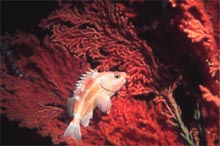
A yelloweye rockfish and a red tree coral at 146 m depth in Whale Bay, off Baranof Island in southeast Alaska. Photo courtesy Victoria O'Connell, Alaska Dept. of Fish and Game. Click image for larger view.
Red Tree Coral: An Essential Fish Habitat
Allen H. Andrews
Research Associate
Moss Landing Marine Laboratories
Many deep-sea corals provide high-relief habitat, some in the form of tree-like structures, which harbor numerous species of fishes and invertebrates. Some of these organisms are commercially important, such as the rockfishes (Sebastes spp.) of the northeastern Pacific Ocean. With many fish stocks declining, it is essential to study the impacts of fishing in more detail.
This perspective was mandated in the Sustainable Fisheries Act of 1996, in which the protection of Essential Fish Habitat (EFH) was deemed to be of paramount importance. It is necessary to understand the longevity and growth rates of habitat-forming coral species before their importance and sensitivity as fisheries habitat can be fully understood. As age determination studies are completed, scientists have found that deep-sea corals commonly reach ages that are on the order of decades to hundreds or even thousands of years.
One example is a deep-water gorgonian coral commonly known as the red tree coral (Primnoa resedaeformis), which is distributed throughout the North Atlantic and North Pacific Oceans. In the Gulf of Alaska and Bering Sea, it inhabits hard substrates along the continental shelf and upper slope (~100 to 800 m) and can form small, isolated groups or massive stands from 2 to 3 m tall. These corals provide the substrate for habitats with high biodiversity. Juveniles and adults of commercially important rockfishes, such as the yelloweye (Sebastes ruberrimus), are among the species associated with this habitat. At a site in the Gulf of Alaska, an occupied submersible transect revealed that 83 percent of the rockfish were associated with red tree coral. Studies of this coral off of Nova Scotia, Canada, indicate that colonies are slow-growing and may exceed 100 yrs in age; the largest colonies may attain ages in the hundreds of years.
Slow-growing Corals
The age and growth characteristics of most corals, gorgonians in particular, are largely unknown. Gorgonians' growth has been estimated by growth-ring counts in the skeleton and by extrapolating linear extension rates; however, validated age and growth is limited to a few radiometric analyses, in which naturally occurring radioisotopes were used to determine an independent estimate of age or growth rate. In a recent study conducted by Moss Landing Marine Laboratories, age and growth characteristics of red tree coral were described by counting growth rings in cross-sections of the coral skeleton. These estimates were then validated using a radiometric aging technique.
This examination provided a range of growth rates. Age estimates from sections taken from the limb of a colony indicated that the limb grew at an average rate of 1.74 cm per year in height. It was further determined that the largest limb studied took approximately 112 yrs to grow from its initial settlement to a total height of 197.5 cm.
Growth rates and age estimates for red tree coral in this study fall within the range of reported values for other gorgonian coral studies. In gorgonians associated with coral reefs, slower growth rates (<1.0 cm per year) are generally reported for deeper-water species, while shallow-water species tend to grow more rapidly (>2 to 3 cm per year). The growth rates reported in this study were at the slower end of the range reported for gorgonians. Shallow-reef gorgonians generally have life spans measured in decades, while deeper species can attain ages in excess of 100 yrs. The maximum age calculated in this study (112 yrs) was not from the tallest colony recorded, suggesting that red tree coral may attain ages far exceeding this estimate.
The Need for Further Study
The slow growth and high longevity of red tree coral make this species, and the habitat it creates, vulnerable to disturbances. During a submersible survey at a site in the Gulf of Alaska, 50 percent of the red tree coral had been broken or removed by an experimental fishing trawl; a follow-up survey revealed little recovery after 7 yrs. In the Atka mackerel (Pleurogrammus monopterygius) fishery of Seguam Pass in the Aleutian Islands, gorgonian corals were a major component of the bycatch 20 yrs ago. Now, however, after intensive fishing, corals are an infrequent part of the catch.
Because red tree coral is ecologically important, sensitive to degradation, often exposed to human activities, and slow to recover from damage, the species warrants further study and protection. The Sustainable Fisheries Act of 1996 recognized that healthy fish stocks and sustainable fisheries are dependent upon healthy fish habitat. As a result, the EFH program was created to promote the protection of such habitat. The North Pacific Fishery Management Council has identified living substrates (e.g., corals, sponges, anemones, sea whips) in deep waters as Habitat Areas of Particular Concern (HAPC). Undisturbed stands of red tree coral need to be identified, and specific areas protected from further disturbance, so that we can learn more about this unique "tree of the deep sea."
The study mentioned in this essay was presented at the First International Symposium on Deep-Sea Corals at Dalhousie University, Halifax, Nova Scotia, Canada (July 30-Aug. 3, 2000). The study was funded by a grant through the University of Alaska at Fairbanks, North Pacific Marine Initiative, U.S. Geological Survey grant no. 99HQGR0103. It will be published later this year in the journal Hydrobiologia. That paper will be cited as: Andrews, A.H., E. Cordes, M.M. Mahoney, K. Munk, K.H. Coale, G.M. Cailliet, and J. Heifetz. 2002. Age and growth and radiometric age validation of a deep-sea, habitat-forming gorgonian (Primnoa resedaeformis) from the Gulf of Alaska. In: Biology of cold water corals. Watling, L. and M. Risk (eds.), Special issue of Hydrobiologia, vol. 471.
Sign up for the Ocean Explorer E-mail Update List.















